Baca A.G., Ashby C.I.H. Fabrication of GaAs Devices
Подождите немного. Документ загружается.

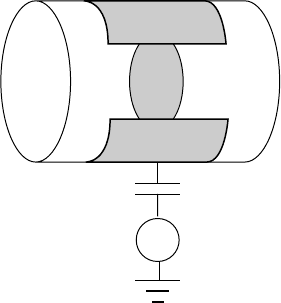
Dry etching of GaAs and related alloys
Cl-containing gas for very long after etching, when the wafer has
already been heated by ion bombardment, should generally be
avoided. However, a slight amount of chemical etching may serve
to remove some of the ion-induced near-surface damage so a brief
opportunity for thermal reaction may improve surface electronic
properties.
5.6 PLASMA ETCHING AT VERY LOW ION ENERGIES
Although most dry etch processes employ a plasma to generate
highly reactive atoms and radicals, the term plasma etching (PE)
is generally applied to processes where there is negligible bom-
bardment with high-energy ions. In PE, the wafer sits within the
plasma but it is not on a powered electrode and few if any ions
with energies over 10 eV strike the GaAs surface (FIGURE 5.4).
The atomic-displacement threshold energy for GaAs is of the order
of 40 V, so processes at energies below that value do not produce
lattice damage that can degrade device operation.
~
FIGURE 5.4 Barrel etcher for
low-energy plasma etching.
Rates can be fast when samples are heated but profiles are
isotropic. Rates up to 5 μm/min can result at 5 mtorr and 60
◦
C.
However, surfaces are virtually damage free. PE is not generally
used for regular GaAs etching because it lacks the primary advant-
ages of profile control provided by energetic ion bombardment in
other dry etching techniques while involving much more expensive
and complicated hardware than wet etching.
Because PE is a low-damage process, it can sometimes be
used to remove surface damage produced by more commonly
employed dry processes. A PE process can be implemented in
a high-density plasma etcher while the reactant-generating ICP
or ECR power is on by reducing the power of the RF-powered
electrode to produce very low bias voltages (<10 V) at the end
of the etch. This can remove the thin surface layer that has been
damaged by ion bombardment during the etch. Etch rates are low
due to the low pressures (<10 mTorr) used in these processes, so
profile degradation is avoided.
While PE is not very useful for GaAs patterning, it is very
useful for removal of residual organics from PR processes when
an oxygen plasma is used. The hardware for this process is some-
times referred to as an asher. The low ion energy avoidsdegradation
of the surface electronic properties of the GaAs while the oxygen
atoms remove trace organic contamination from the surface where
photoresist has been removed during PR pattern development
before etching. This permits better pattern definition during the
etch process. It is equally valuable after solvent removal of most
of the photoresist following an etch. Without this PE cleaning
152
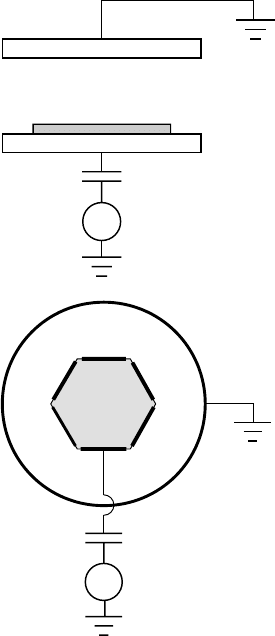
Dry etching of GaAs and related alloys
of the surface, it would be difficult to obtain highly reproducible
metal-semiconductor contacts.
5.7 CONVENTIONAL REACTIVE ION ETCHING (RIE)
Reactive ion etching (RIE) is the workhorse of dry etching tech-
niques for GaAs. The equipment involved is widely available
in most clean rooms and uses the most reasonably priced basic
hardware of any of the dry processes. Two geometries have been
commonly employed: planar and hexode (FIGURE 5.5). In the
planar geometry, which is by far the most common, the radio fre-
quency (RF) plasma is formed between two parallel plates with
one electrode powered and the other grounded. In the hexode geo-
metry, wafers are mounted on a hexagonal column located within
a grounded chamber. Most reactors today are of the planar variety.
In both cases, RF power is applied to the electrode upon which the
wafers sit.
~
~
(a)
(b)
FIGURE 5.5 Typical RIE
etchers. Wafer sits on powered
electrode: (a) Planar (b) Hexode.
Because of the RF character of the applied power, the actual
voltages present at the powered electrode vary with time during
the RF cycle, making the environment experienced by the wafer
more complex than is implied when describing the plasma system
in terms of input power or even applied bias voltage (FIGURE 5.6).
Typical commercial RF plasma hardware operates at a frequency
of 13.56 MHz. The rapidly varying potential allows the elec-
trons, which have very high mobilities, to respond to the varying
RF potential. However, the ions, being much heavier and pos-
sessing much lower mobilities, respond only to the time-averaged
potential, V
dc
.
The time-averaged potentials at different locations between the
powered and grounded electrodes are shown in FIGURE 5.7. Ions
are accelerated in the field and strike the wafer at energies between
e(|V
dc
|+V
p
) and zero. In a typical reactor, where the area of the
grounded surfaces is large compared to the area of the powered
electrode, V
p
will be relatively low (20–50 V) and the maximum
energy of ions incident on the wafer is reasonably well described,
within about 10%, by V
dc
. Because it is the energy of the incident
ions that is so important in determining the etching characteristics,
it is important to measure the DC potential of the cathode (powered
electrode) whenever possible rather than using the RF power alone
to describe an etching process.
The same RF powersupply both dissociates the source gasesinto
more reactive radicals and ions and provides the ion acceleration
voltage that determines the ion bombardment energy during the
etch cycle. This means that there is no independent or even semi-
independent control of the degree of dissociation in the plasma and
153
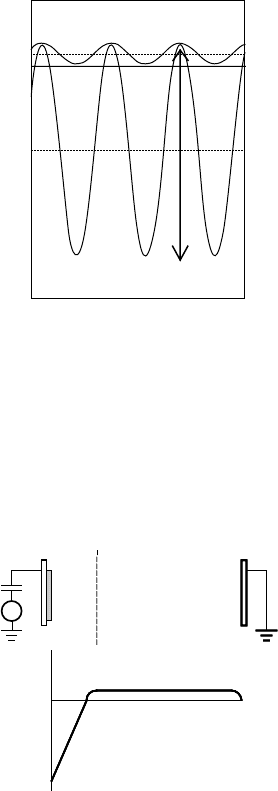
Dry etching of GaAs and related alloys
the energies of the ions striking the wafer. The wafer is etched by
neutrals and by ions whose energies are greater than the positive
space-charge potential of the plasma.
V
rf
time
V
dc
V
p
0
V(t)
FIGURE 5.6 Time-dependent
variation of voltages during several
RF cycles in an RIE reactor. V
p
=
plasma potential: time-average of
potential through most of plasma
and at grounded electrode; V
dc
=
self-bias potential: time-average of
potential at powered electrode.
V
ave
V
dc
V
p0
~
cathode dark
space (sheath)
negative glow
FIGURE 5.7 Time-averaged
potential in a planar RIE etcher.
It is important to remember that a plasma is actually a com-
plex mixture of ions, electrons and neutral species. In etching
plasmas, the neutrals greatly outnumber the ions, and a complete
description of the plasma would require knowledge of the number
and identity of the neutral species in the plasma as well as the
range of ion energies and ion densities. In addition, there are ener-
getic neutrals which form when electrons are transferred between
energetic ions and neutrals. Depending on where in the sheath
the neutralisation occurs, the incident neutral energy will vary
widely. The degree of ionisation (ion/neutral ratio) is usually in
the range of 10
−4
–10
−6
, so it is clear why etch contributions
due to neutrals are so important and why it is so difficult to
fully characterise what species are actually reacting at the wafer
surface.
The energies of individual ions striking the wafer will depend on
their history. As an ion passes through the sheath as it accelerates
towards the cathode, it may undergo collisions that alter its energy
and charge state. Some ions may be neutralised by collisions with
neutral species. This can produce an energetic neutral that moves
towards the wafer with an energy determined by how much it had
been accelerated prior to the neutralisation. The new ion resulting
from the collision will accelerate towards the surface and strike
with a fraction of the maximum possible energy. The result is
an energy spread of up to several hundred eV for the chemical
species striking the surface. Consequently, reaction at the surface
will involve a complex mixture of low-energy neutrals and ions
and higher energy neutrals and ions.
Since charge neutrality in the plasma must be maintained, most
ions are positively charged. In a typical RF plasma there may be
10
9
–10
11
ions/cm
3
. In contrast, the neutral density at 10 mTorr
(a typical RIE pressure) is 10
14
–10
15
molecules/cm
3
. Clearly,
neutral species are predominant and will play a vital part in any
RIE process while ions largely affect relative product desorption
rates. Ions accelerate product desorption where they strike, so
rates on bombarded surfaces become faster than rates on side-
walls, leading to anisotropic profiles. In general, chemical etching
by plasma-generated radicals with its associated high rates, low
anisotropy and low damage is dominant when pressures are high
and sheath voltages are low. As pressure increases, reactant con-
centrations increase, but at the same time ion energy decreases due
to the decreasing self-bias voltage. Since rates tend to decrease
with decreasing ion energy, increasing pressure first increases
etch rates by increasing reactant supply, then decreases them
154
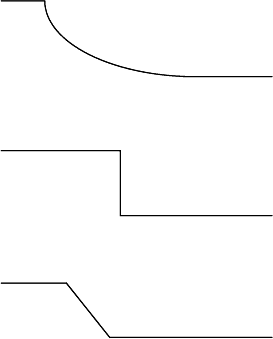
Dry etching of GaAs and related alloys
as the rates shift from reactant-supply dominated to ion-energy
dominated.
In contrast, sputtering is dominant at low pressures and high
sheath voltages. This increases both the anisotropy and the damage
while reducing the material selectivity of an etch process. Higher
ion fluxes at a fixed energy and higher ion energies at a fixed
flux increase the sputtering rates. Higher fluxes and energies also
deposit more energy into the wafer and can produce substantial
heating if the wafer is not actively cooled. This will accelerate the
chemical reaction rates, including those with neutral molecular
species. The profile evolution from the mostly chemical (low ion
energy) to mostly sputtering (high ion energy) is illustrated in
FIGURE 5.8.
chemical etching
both mechanisms
physical sputtering
FIGURE 5.8 Profile evolution
depending on ion and neutral
contributions.
It is customary to describe process conditions in terms of pres-
sure, gas flow rate, RF power and applied bias, but this is grossly
inadequate to define the chemical characteristics of a plasma. The
great importance of the neutral species, which are not directly
measured by any of the diagnostics on standard reactors, and the
variation in ion densities at different energies are the probable
origin of the markedly different etching rates obtained with nom-
inally identical RF power even in nominally identical reactors from
the same manufacturer. Rates reported in the literaturefora specific
set of conditions should always be taken only as guidelines and
starting points when transferring a process into a different reactor.
Each reactor must be individually characterised with a process for
reliable etching results to be obtained. Some RIE rates and their
associated reaction conditions are listed in TABLE 5.1.
5.7.1 Halogen-based plasmas for RIE
A variety of chemistries have been employed in RIE of GaAs, but
the most commonly used ones are halogen-based (F, Cl, Br, I).
The most common ones employ Cl
2
and BCl
3
, separately or in
combination. SiCl
4
is another good Cl source gas. Rates can vary
by two orders of magnitude. Processes with intermediate rates tend
to produce good surfaces. Higher etch rates, such as those produced
when Cl
2
is the sole source of Cl, tend to produce rougher surfaces
and decreased anisotropy.
Typical chemistries employ Cl-based source chemicals, such
as Cl
2
and BCl
3
, that are dissociatively excited in the plasma to
produce Cl atoms that react readily with the GaAs surface. The
removal of the products GaCl
3
and AsCl
3
is facilitated by the
simultaneous ion bombardment that sputters away the products
from the surface, producing much faster etch rates where the ions
strike than in regions without ion bombardment. Sputtering can
remove even partially chlorinated GaCl
x
and AsCl
x
(x = 1–3),
155

Dry etching of GaAs and related alloys
TABLE 5.1 Reactive ion etching rates for GaAs.
Etchant Rate Pressure Flow RF power Self Ref. Comments
(μm/min) (mTorr) (sccm) density bias
(W/cm
2
)(−V)
Cl
2
4.5 150 3–23 0.44 [a] via drilling
3.0 85 0.8 400 [b]
1.4 5 270 [c] vertical walls
0.15 2 40 0.1 150–160 [d] low damage, semi-isotropic
5Cl
2
: 3Ar 0.09 5 20 0.14 300 [e] equirate versus AlGaAs
and vertical profile
4Cl
2
: 1Ar 0.80 5 200 [c] severe undercut
3Cl
2
: 1Ar 3.4 15 12 0.75 330 [f] isotropic
1Cl
2
: 5BCl
3
0.6 60 0.42 270 [g] high reproducibility
1Cl
2
: 1BCl
3
: 3Ar 0.9 15 100 – 300 [h] very smooth vias
BCl
3
0.017 11 20 0.20 [i] very smooth
1BCl
3
: 9Ar 0.28 15 0.27 300 [j] equirate versus AlGaAs profiles,
resolution, rates f(W,P gases)
SiCl
4
0.129 10 10 0.81 600 [k] no polymer film
0.067 10 10 0.27 275 [k] no polymer film, max. at 10 mtorr
1SiCl
4
/4SiF
4
0.31 60 10 – 60 [l] 490 : 1 versus Al
0.35
Ga
0.65
As
1CH
4
:5H
2
0.016 10 24 0.75 500 [m] donor passivation
1C
2
H
6
:3H
2
0.036 10 43 1.1 500 [n,o]
1C
3
H
8
:5H
2
0.038 10 41 1.1 500 [n,o] 2 : 1GaAs/AlGaAs
[a] K.P. Hilton, J. Woodward [Electron. Lett. (UK) vol.21 (1985) p.962]
[b] C. Gagne [Solid State Technol. (USA) (May 1988) p.187]
[c] E.L. Hu, R.E. Howard [J. Vac. Sci. Technol. B (USA) vol.2 (1984) p.85]
[d] B.S. Lee, H. Baratte [J. Electrochem. Soc. (USA) vol.137 (1990) p.980]
[e] S.S. Cooperman, H.K. Choi, H.H. Sawin, D.F. Kolesar [J. Vac. Sci. Technol. B (USA) vol.7 (1989) p.41]
[f] H. Yamada, H. Ito, H. Inaba [J. Vac. Sci. Technol. B (USA) vol.3 (1985) p.884]
[g] H. Tamura, H. Kurihara [Jpn. J. Appl. Phys. (Japan) vol.23 (1984) p.L731]
[h] K.J. Nordheden, D.W. Ferguson, P.M. Smith [J. Vac. Sci. Technol. B (USA) vol.11 (1993) p.1879]
[i] G.J. Sonek, J.M. Ballantyne [J. Vac. Sci. Technol. B (USA) vol.2 (1984) p.653]
[j] A. Scherer, H.G. Craighead, E.D. Beebe [J. Vac. Sci. Technol. B (USA) vol.5 (1987) p.1599]
[k] M.B. Stern, P.F. Liao [J. Vac. Sci. Technol. B (USA) vol.l (1983) p.1053]
[l] W.H. Guggina, A.A. Ketterson, A. Andideh, J. Hughes, I. Adesida, S. Caracci, J. Kolodzey [J. Vac. Sci. Technol. B (USA) vol.8 (1990)
p.1956]
[m] J. Werking, J. Schramm, C. Nguyen, E.L. Hu, H. Kroemer [Appl. Phys. Lett. (USA) vol.58, no.18 (1991) p.2003–5]
[n] V.J. Law, G.A.C. Jones, M. Tewordt [Semicond. Sci. Technol. (UK) vol.5 (1990) p.1001–3]
[o] V.J. Law, M. Tewordt, S.G. Ingram, G.A.C. Jones [J.Vac. Sci. Technol. B. (USA) vol.9, no.3 (1991) p.1449–55]
accelerating the total GaAs etch rate. This difference in etch rate
between surfaces with and without ion bombardment is the origin
of the profile control available with dry etching. The undercutting
of the mask that results in wet etching from nearly equal vertical
and horizontal etch rates is avoided by increasing the vertical etch
rate through sputtering away the intermediate and final reaction
products rather than relying solely on the natural volatility of the
final products. Depending on the degree of sputtering in a given
process, profiles can be varied from isotropic undercut, as in purely
chemical processes, through vertical to angled, as in IBE without
any chemical contributions.
156
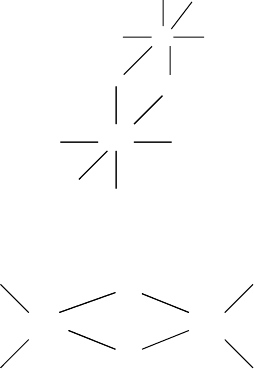
Dry etching of GaAs and related alloys
The highest rates are achieved with Cl
2
as the Cl atom source, but
Cl
2
can produce surface roughness and may exhibit low reprodu-
cibility in etch rates from run to run. The very high rates are due to
a strong chemical component, and reduced anisotropy and surface
roughness can be a problem. The performance of Cl
2
is improved
by the addition of other gases. Addition of Ar or BCl
3
increases
anisotropy by increasing the sputtering contribution while addition
of some H
2
toaCl
2
/Ar mixture increases both surface smoothness
and anisotropy while decreasing the etch rate somewhat. Addi-
tion of CH
4
to Cl
2
/Ar yields smoothness, anisotropy and a rapid
etch rate. However, addition of H-containing sources to the gas
mix produces H atoms that can passivate dopants and may require
post-etch annealing to reactivate them.
BCl
3
or BCl
3
/Cl
2
mixtures tend to produce smoother surfaces
than Cl
2
-only plasmas. The smooth morphology, good anisotropy
and high degree of reproducibility make the BCl
3
-based etches
some of the best. BCl
3
can also act as a getter for oxygen atoms
that are formed in the plasma from residual O
2
or H
2
O. The product
of this reaction is the volatile trimer B
3
Cl
3
O
3
. SiCl
4
may also serve
this gettering purpose. Therefore, if one must work with a non-
loadlocked reactor, use of a BCl
3
-based chemistry is especially
advantageous since even trace oxygen can retard the etching of
AlGaAs.
When etching heterostructures of GaAs and AlGaAs, either
highly selective etching of one versus the other or equirate etch-
ing of the two materials may be desired. Either may be achieved
with the selection of proper reactants and RF plasma conditions.
Selective removal of GaAs is needed for the gate recess of HEMTs
where the ohmic contact layer must be removed to expose the
donor layer for gate oxide deposition. Similarly in the emitter mesa
process for HBTs, the GaAs contact layer is removed from the
wide-bandgap emitter first before etching the emitter and exposing
the base for contact formation.
Ga Ga
F
F
F
FF
F
Al
FF
F
F
F
F
F
Al
FIGURE 5.9 GaF
3
dimer and
AlF
3
octahedral matrix.
One of the best ways to achieve selective etching of GaAs versus
AlGaAs is through the addition of an F-containing reactant to the
gas mixture. The formation of relatively non-volatile AlF
3
on the
surface of the AlGaAs greatly reduces the etch rate. In contrast,
GaF
3
is readily removed from the surface so etching of GaAs
proceeds relatively unimpeded. The origin of this pronounced dif-
ference is found in the structures of GaF
3
and AlF
3
. While GaF
3
forms the dimer, (GaF
3
)
2
, which is quite volatile, AlF
3
forms an
extended octahedral network that must be broken up and mechan-
ically ejected by physical sputtering (FIGURE 5.9). Consequently,
at the lower bias voltages that one generally employs for selective
etching, the octahedral AlF
3
network can serve as a barrier to
further etching. The formation of a similar octahedral network
157
Dry etching of GaAs and related alloys
by InCl
3
accounts for the slower etch rates of InAs, InGaAs and
InGaP versus GaAs. Selectivity will be degraded at high ion ener-
gies where physical sputtering can dominate over the formation of
non-volatile surface chemical products.
A good source of F atoms is SF
6
. With SiCl
4
/SF
6
mixtures of
varying mole ratios, GaAs : AlGaAs etch ratios from 1 : 1 to 500 : 1
have been demonstrated. This large difference in etch rate permits
the use of AlGaAs as an RIE etch-stop layer, with the required
thickness of the AlGaAs layer being lower for higher Al mole
fractions. However, the ion-induced damage below the etch stop
may be problematic for some applications.
Etches employing SiCl
4
generally produce better surface mor-
phologies, greater anisotropy and less change in surface stoi-
chiometry than the analogous Cl
2
-based etches. SiCl
4
produces
little As loss, while Cl
2
-etched surfaces are quite As deficient.
Since the surface stoichiometry can strongly affect the surface
electronic properties through the presence of a different distribu-
tion of surface states, the choice of etchant can be important to final
device performance. There also appears to be less Cl-containing
residue on an SiCl
4
-etched surface. However, Si can be incor-
porated into the near-surface region by ion implantation at biases
above 250 V and can be present at the 10
19
/cm
3
level at the sur-
face, although the level drops rapidly to <10
15
/cm
3
at 30 nm with
a 250-V etch bias. While this may be advantageous for forming
good ohmic contacts on n-type material, it could be a problem
for p-type if the top surface were not etched away before contact
formation.
A frequently unintentional way to obtain selective GaAs etch-
ing is to have appreciable amounts of water or oxygen adsorb on
the reactor walls during sample loading without the aid of a load-
lock. A loadlock is an extremely valuable equipment feature when
any readily oxidised material, such as AlGaAs, is to be etched. It
consists of an antechamber to the actual etching chamber where
the sample can be inserted and the moist, oxygen-containing atmo-
sphere can be pumped away before transferring the wafer into the
plasma chamber. This avoids adsorption of significant quantities
of water or oxygen on the plasma chamber walls, which sub-
sequently serve as sources of oxygen when the plasma discharge
is on. The great ease of oxidation of Al leads to the formation
of a thin aluminium oxide surface layer that retards etching of
the underlying AlGaAs even at the low oxygen concentrations
available from wall desorption. While GaAs will etch well in
non-loadlocked systems, more reproducible results are favoured
by using a loadlock system for these materials as well. With a
loadlock, equirate etching of AlGaAs and GaAs is possible when
desired.
158
Dry etching of GaAs and related alloys
When equirate etching is desired, the most important require-
ment is a load-locked reactor to avoid formation of aluminium
oxide on the surface. It is also important not to have residual
F present in the reactor. If F-based chemistries have been used
in a reactor prior to an equirate etching process, it will be import-
ant to run a reactor-chamber cleaning process before subjecting
valuable substrates to RIE processing in the reactor.
Other halogen-based plasmas that generate Br or I atoms will
etch GaAs, but these do not, in general, have major advantages
relative to Cl-based chemistries. A major practical problem is the
greater rate of corrosion of the process tool with Br or I.
There may be an advantage to performing a brief water rinse
after Cl-based etching to remove any residual Cl compounds from
the surface that might later contribute to corrosion problems.
5.7.2 Alkane-based plasmas for RIE
A useful alternative to Cl-based plasmas are plasmas employing
alkanes (C
x
H
y
) as the source of reactive radicals. The simplest
alkyl radical formed in these plasmas is the methyl radical, CH
3
.
Organometallic compounds, such as Ga(CH
3
)
3,
are formed by
reaction with Al, Ga or In. These are the same compounds used as
sources of the Column III atoms in metalorganic chemical vapour
deposition (MOCVD). While In does not etch well with Cl-based
chemistries due to the formation of the non-volatile octahedral
(InCl
3
)
x
structure (similar in structure to AlF
3
in FIGURE 5.9),
it does etch well with the alkyl radicals formed in alkane plas-
mas. Consequently, these chemistries are important despite some
practical disadvantages.
The primary problem with alkane plasmas is the ready forma-
tion of polymers with the general composition (CH
2
)
x
. Care must
be taken to minimise polymer deposition on the GaAs wafer or
etching will stop as a thick polymer layer blocks access of the
GaAs to reactive alkyl radicals. This problem can be avoided or
minimised by the addition of H
2
to the gas mixture. The hydrogen
helps remove polymer by reacting with the polymer to form volatile
alkanes that readily desorb from the surface. The addition of heavy
ions, such as Ar, delays the onset of polymerisation and improves
surface morphology, but the chemical effects of hydrogen pre-
dominate in controlling polymer buildup. Rates initially increase
with increasing hydrogen as polymerisation is reduced, but further
increases in hydrogen lead to lower rates due to dilution effects. In
general, alkane/H
2
ratios between 0.2 and 0.4 work well, with the
optimum ratio following the order propane < ethane < methane.
While hydrogen reduces the polymer buildup, hydrogen passiv-
ation of dopants requires post-etch thermal anneals at temperatures
159
Dry etching of GaAs and related alloys
near 400
◦
C to restore electrical activity. The activation energy for
recovery of donor activity is about 1.75 eV so a 360
◦
C anneal for
5 min gives almost complete reactivation of Si dopants. The depth
of Si dopant passivation by H increases with increasing substrate
temperature during etching and with increasing etch time. Higher
ion energies make reactivation more difficult. With C
2
H
6
/H
2
etch-
ing at a 410 V self-bias, almost 500
◦
C is required for restoration
of initial carrier concentrations. This is the combined effect of
H dopant passivation and the damage caused by deep penetration
of the light H ion into the substrate by ion implantation.
While thermal annealing above 400
◦
C can reactivate dopants
by dissociating the bound H, the released H can diffuse deeper
into the device so trying to minimise H diffusion during etching
is advisable. In addition, annealing can cause vacancies to diffuse
deeper in the wafer, resulting in electrically active defects. Defect
reactions are discussed in some detail in Section 10.2.2. Annealing
techniques are discussed in Section 7.2.1.
An important practical problem with alkane etches is the build-
up of polymer on chamber walls where ion bombardment does
not occur. Even under optimised etching conditions, frequent and
regular oxygen plasma cleaning is essential.
5.8 HIGH-DENSITY PLASMA ETCHING (HDPE)
A single power supply is used in conventional RIE both to generate
the plasma and to providethe bias potential for accelerating the ions
into the wafer surface. Consequently, one does not have independ-
ent control of the energy of the incident ions and of the degree of
dissociation of the source gases into highly reactive neutrals and
ions. To achieve a high degree of dissociation, high RF powers
are needed but high powers also produce high bias voltages and
more damage. Since it is highly desirable in most cases to minim-
ise damage by minimising ion energy, one would like to be able
to produce a high degree of dissociation to get rapid etching while
keeping bias voltages below 200 V.
This problem has been solved in high-density-plasma etching
where the reactors employ separate power supplies to generate
the reactive plasma species and the ion acceleration voltage. The
use of two separate supplies permits semi-independent control of
the degree of dissociation and the incident ion energy so high etch
rates can be achieved with minimal damage. The ion acceleration
voltage is still provided by a capacitively coupled RF power supply
operating at 13.56 Mz and the wafer sits on the powered electrode.
However, the reactant source gases are dissociated into reactive
neutrals and ions using either electron cyclotron resonance (ECR)
160
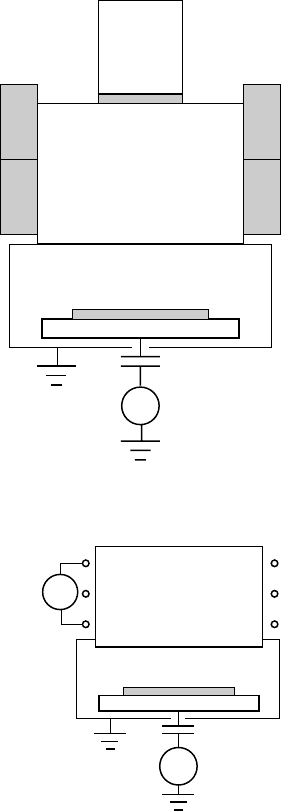
Dry etching of GaAs and related alloys
excitationwithmicrowaves, typically at 2.45 GHz (FIGURE 5.10),
or using an inductively coupled plasma (ICP) typically operating
at 2 MHz (FIGURE 5.11).
~
Plasma
m wave
2.45 GHz
13.56 MHz
Magnets
FIGURE 5.10 ECR-HDPE reactor.
13.56 MHz
2 MHz
Plasma
~
~
FIGURE 5.11 ICP-HDPE reactor.
Although many of the same source gases are used in RIE and
HDPE, the actual plasma composition is radically different. HDPE
plasmas are much more highly dissociated into ions, free atoms
and other radicals, producing much faster etching at lower pres-
sures than with RIE. Ion densities in an HDPE reactor can exceed
those in conventional RIE by two to four orders of magnitude
(up to 10
13
ions/cm
3
). Typical pressures in HDPE reactors are
between 1 and 10 mTorr while RIE employs pressures of the order
of 5–100 mTorr. Some typical rates and their associated reaction
conditions are listed in TABLES 5.2 and 5.3.
The greatest advantage of HDPE versus RIE is the much lower
ion bombardment energies that are used. Whereas is it difficult
to achieve good etch rates and feature profiles at 100-V bias with
RIE, a 100-V bias produces both good rates and vertical profiles
with HDPE.
In general, a reactive gas mixture and pressure that performs well
in ECR will also perform well in ICP. Comparable etch rates can
be obtained by proper selection of microwave and ICP powers to
permit translation from one platform to the other. A significant
practical difference between ICP and ECR etchers is the use of
magnets to confine the plasma and collimate the ions in the ECR.
This gives some extra degrees of control that can be effectively
used to tune the composition of an ECR-plasma deposition, such
as changing the O : N ratio in SiO
x
N
y
films. For etching, however,
the need to tune the magnets in ECR is more bothersome than
helpful, and ICP hardware is easier to use.
From a practical perspective, the tuning of the magnets that
may be required to minimise reflected microwave power when
the plasma first ignites can lead to some variation in performance
for very shallow etches where the plasma on-time must be short.
For very shallow etches, an appreciable fraction of total plasma
time may be involved in the tuning, leading to reproducibility
problems. For deeper etches requiring longer etch times, this is
not a significant factor. ICP systems, in contrast, do not require
manual tuning and tend to stabilise faster, but in any plasma system
there are voltage excursions when the plasma first strikes. Since
these are not identical from run to run, some variation will occur
for very shallow etching in ICP and RIE etches as well.
Selective etching of GaAs versus AlGaAs or InGaP can be
achieved in HDPE with the same chemistries that work in RIE,
but some selectivity is lost with the higher density plasmas. For
example, using 20% SF
6
in BCl
3
at 5 mTorr and only 50 W RF
power, selectivities of GaAs versus AlGaAs or InGaP that exceed
161
